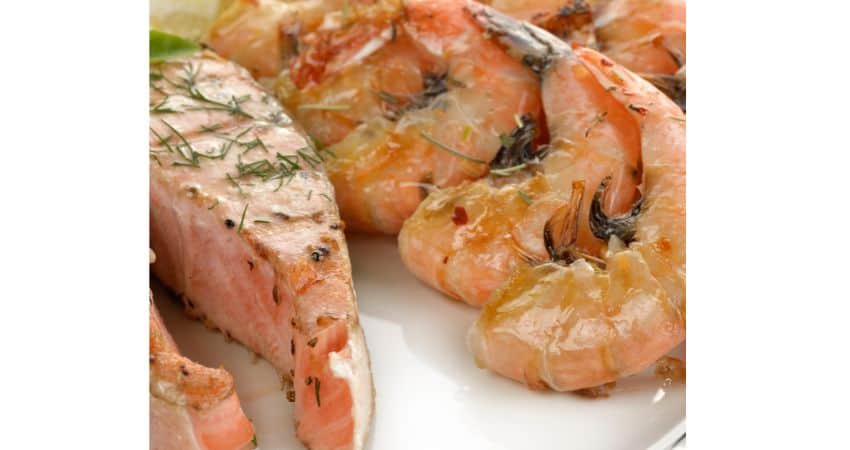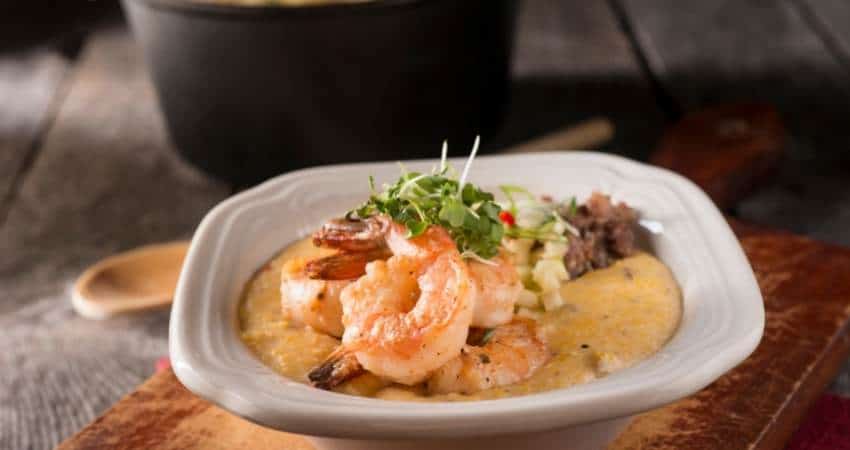Shrimp vs. Salmon: A Complete Comparison
Salmon and shrimp are some of the most commonly known and consumed seafood. Some people have asked, what is healthier salmon or shrimp?
Salmon is healthier than shrimp because it contains 2,260 mg of Omega-3 fatty acids compared to 295 mg for shrimp. Salmon provides more protein, Vitamin C, folate, potassium, niacin, phosphorus and selenium than shrimp. Shrimp contains more than twice the cholesterol.
Salmon and shrimp are both recommended fish choices by the U.S. Food & Drug Administration. Therefore, this article will make a complete comparison of the two including nutritional value, health, tastes and which one is better for weight loss.
As a Certified Health Coach I get asked about salmon and shrimp all the time. My clients ask many questions which I researched and will inform you of in this article.

Shrimp vs Salmon Nutrition
| Nutrient | Salmon, Farmed/Cooked (3.5 Ounces) | Shrimp/Cooked (3.5 Ounces) |
| Calories | 206 | 84 |
| Fat | 12.3 g | 0.9 g |
| Protein | 22.1 g | 17.8 g |
| Omega-3 | 2,260 mg | 295 mg |
| Omega-6 | 666 mg | 17.9 mg |
| B-6 | 0.6 mg | 0.1 mg |
| B-12 | 2.8 mcg | 1.3 mcg |
| Vitamin C | 3.7 mg | 1.9 mg |
| Vitamin A | 50.0 IU | 191 IU |
| Niacin | 8.0 mg | 2.2 mg |
| Folate | 34.0 mcg | 3.4 mcg |
| Potassium | 384 mg | 155 mg |
| Magnesium | 30.0 mg | 28.9 mg |
| Phosphorus | 252 mg | 116 mg |
| Calcium | 15.0 mg | 33.2 mg |
| Zinc | 0.4 mg | 1.3 mg |
| Selenium | 41.4 mcg | 33.7 mcg |
What really separates the two and gives salmon the edge over shrimp is the number of omega-3 fatty acids1. What makes omega-3s so important for your health?
Omega-3 fatty acids are considered essential because your body doesn’t make them and the only way to get them is from your diet. Omega-3s have been shown in studies to improve artery health, reduce inflammation, lower blood pressure and reduce the risk of disease2.
The Journal of the American Heart Association published a study, from an updated study by JAMA Cardiology, which found fish with omega-3 supplements lowered risk for heart attacks and death from coronary heart disease3.
Although salmon is considered healthier, shrimp is still considered a healthy fish and provides almost the same magnesium and selenium. Shrimp contains more zinc, calcium, vitamin A and less calories than salmon4.
Shrimp contains more than twice the cholesterol than salmon. Shrimp contains 166 mg and salmon has 53.5 mg. The Dietary Guidelines for Americans5 list both shrimp and salmon in their list of best fish choices to eat.
How did sardines compare to salmon? Find out in my article, Sardines vs Salmon: A Complete Comparison.
Shrimp Or Salmon For Weight Loss
Many people are looking to lose weight, and the type of food consumed can make a difference with weight loss. If you fit into this category, you’ll want to know which one is better for weight loss.
Shrimp contains less calories when consuming an equal number of ounces between shrimp or salmon. A 3.5 ounce serving of salmon contains 206 calories, and shrimp contains 84 calories. The lesser number of calories contained in shrimp is better for weight loss.

Shrimp vs Salmon: Taste
Salmon has a rich, oily, non fishy taste compared to shrimp’s more fishier, sweeter taste. Shrimp has a meatier texture while softer salmon breaks apart easier than shrimp.
Salmon is softer and can be eaten easily without cutting with a knife. Salmon will break apart using a fork only. Shrimp doesn’t break apart and has to be eaten whole or cut with a knife or biting.
My Taste Poll
I wanted to conduct some original research so I set up a poll. I asked friends, family and readers which one they preferred to eat based on taste only.
Out of 35 people 20 chose shrimp over salmon for taste. Therefore, the results of my poll showed 54% of the people liked shrimp over salmon based on taste.
Salmon is a powerhouse and so is trout. Check out my article and find out which one is healthier, Trout vs Salmon: Is One More Healthier Than The Other?
The Cost of Shrimp and Salmon
The cost of either shrimp or salmon will differ depending on the location, fresh or frozen and whether it’s farm raised or wild caught. Which is more expensive, shrimp or salmon?
Salmon is more expensive than shrimp. The average cost for salmon is $12.49 per pound while the average cost for shrimp is $10.99 per pound. The cost will vary depending on location, whether it is farm-raised or wild-caught, fresh or frozen.
To conduct more original research, I checked my local Shoprite Supermarket for the current prices of each.
- Fresh, farm raised shrimp
- $8.99 per pound.
- Fresh, wild caught shrimp
- $12.99 per pound
- Fresh, farm raised Atlantic salmon
- $9.99 per pound
- Fresh, wild caught Coho salmon
- $14.99 per pound
Salmon vs Shrimp: Mercury Levels
The Food and Drug Administration and the Environmental Protection Agency (EPA) have issued warnings regarding mercury levels. They also provide recommendations about how often people should consume certain seafood6.
The FDA established a list of best choices, good choices and ones to avoid.
Shrimp have less mercury than salmon but both fish are listed on the FDA’s best choices of fish to consume regarding their mercury levels. They recommend consuming them no more than two servings a week.
Always check with a physician prior to eating new foods or changing your dietary habits.
How Different Do Salmon and Shrimp Look?
Shrimp and salmon look nothing alike. Salmon are several times bigger, have fins, large mouths and eyes. A shrimp is smaller, has ten legs and plated gills. Let’s explain their differences in detail.
A Salmon’s Appearance
Depending on the salmon, they fish often have silver, brown or dark green skin. They’re equipped with many fins to propel themselves through the water.
Most salmon have a light-colored body that makes them distinguishable from other fish with dark-colored skin7.
Since there are so many types of salmon, it’s impossible to pinpoint a uniform appearance. There are six primary species of salmon in the world, but many subspecies can add up to dozens of appearances.
A Shrimp’s Appearance
A shrimp has ten legs, a curved body and plated gills that protect them from predators8. Unlike salmon, they can stop and change directions, often swimming backward.
According to the Florida Fish and Wildlife Conservation Commission9, a shrimp’s unique body shape lets them wiggle back and forth to determine their direction rather than relying on fins.
Shrimp can’t eat much more than decaying plants, algae and dead insects, but they have countless predators. Many shrimp have a sharp beak on the front of their face as a defense mechanism against fish and crustaceans of similar size.
There are many other differences between salmon and shrimp, including the fact that a shrimp weighs about 3 grams, whereas some salmon weigh over 13,000 grams.
If you have any questions to ask me about this article don’t hesitate to comment below or email us. You can find an email on our contact page.
Read Next – More Food vs Food Articles!
Char vs. Salmon – A Complete Comparison
Salmon vs Chicken: Which Is Healthier?
Salmon Oil vs Fish Oil: Which Is Better?
Farm Raised Salmon Compared To Wild Caught Salmon
Frozen Salmon vs Canned Salmon: Which is Healthier?
- NutritionData: Salmon [↩]
- National Center for Biotechnology Information: Risk and benefits from consuming salmon and trout: a Canadian perspective [↩]
- National Center for Biotechnology: Marine Omega-3 Supplementation and Cardiovascular Disease [↩]
- NutritionData: Shrimp [↩]
- USDA: Dietary Guidelines [↩]
- FDA: Advice about Eating Fish [↩]
- The University Of Maine: Maine Seafood Guide – Salmon [↩]
- US Affiliated Pacific Food Guide: Shrimp (Caridea) [↩]
- Florida Fish and Wildlife Conservation Commission: Shrimp FAQ [↩]
